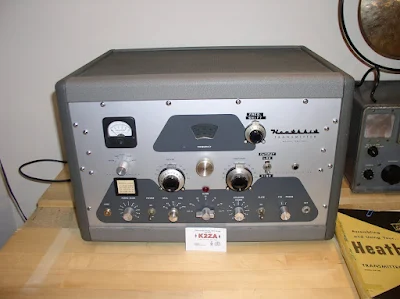 Today was big day here at SolderSmoke HQ. John, K2ZA, and his lovely wife Erika drove down from New Jersey bringing with them the Heathkit DX-100 that John's dad (now a silent key) had built years ago. John heard me mention my long yearning to once again own a DX-100 (I'd had one as a kid); he very generously decided to give me his dad's.
Today was big day here at SolderSmoke HQ. John, K2ZA, and his lovely wife Erika drove down from New Jersey bringing with them the Heathkit DX-100 that John's dad (now a silent key) had built years ago. John heard me mention my long yearning to once again own a DX-100 (I'd had one as a kid); he very generously decided to give me his dad's. It's beautiful. And BIG: Shipping weight: Over 100 pounds. This, gentlemen, is the rig that they were talking about when they first started to refer to certain transmitters as "boatanchors."
After some time on a Variac, I plan on pairing this magnificent transmitter up with a suitable thermionic-based receiver. Maybe the HQ-100. Then I will put it on 75 meter AM and will attempt to establish myself as one of the plate-modulated, big signal anointed, perhaps even attaining "tall ship" status. We can dream...
Getting the DX-100 was great, but even nicer was meeting John and Erica. What nice people they are!
John and I recorded (in both video and audio) a short segment about the DX-100. I will plug the audio into SolderSmoke #131, and will upload the video to the SolderSmoke YouTube page.
Here's John with the Drake 2-B, the HT-37, and the INFAMOUS Astatic D-104:












